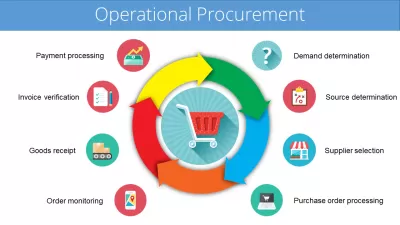Modern Procurement Process Guide: Concepts and Steps
- What is the procurement process
- Best practices in the procurement process
- Stages of the procurement process
- Step 1. Determination of needs
- Step 2: Choosing a supplier
- Request for quotes.
- Auction.
- Contest.
- Request for proposals.
- Step 3: Negotiation and contract
- Step 4: Receive the goods
- Step 5: Purchase payment
- Frequently Asked Questions
The procurement process begins from the moment the organization needs a material, product or service from the outside. As soon as the need is defined and formulated, its formalization is carried out. As a result, specific parameters of the necessary are determined. At the same time, the balance of price / quality is very important, because if the characteristics of the procurement object are overestimated, the organization will incur losses, if they are underestimated, the work process will not be adjusted.
A well-organized procurement activity allows you to constantly monitor the needs of the organization, so that warehouses do not overflow and at the same time do not create a shortage of goods, and services are not wasted.
What is the procurement process
Procurement is a holistic process that consists of several stages. The rules according to which it is carried out are regulated by the current legislation. State regulation guarantees the existence of conditions under which open competition and protection of the rights of the parties is possible.
The modern purchasing process usually begins with a buyer recognizing a need for a product and preparing a specification.
And the market-based sourcing process through selection or tendering helps determine the right product and supplier. The procurement process is quite complex and multi-level.
As a rule, a separate employee is responsible for organizing and conducting purchases in the enterprise. Less commonly, a department. The purpose of his work is to synchronize the procurement process with the changing needs of the enterprise and ensure its continuity.
The current tasks that the procurement process must solve include:
- stock creation;
- searching and establishing contacts with reliable suppliers;
- control over the reasonableness of expenses.
Best practices in the procurement process
There are three main procurement practices to successfully monitor the availability of goods and the provision of services:
- regular purchase of the necessary in small batches / for a short time;
- purchase in one large batch / for a long time;
- purchasing goods and ordering services pointwise, as needed.
In this case, one of the popular schemes for organizing the entire process can be used:
- Traditional. A stock of goods is created / a contract for the provision of services is drawn up for a period exceeding the required one. It guarantees the provision of the enterprise with the necessary, but leads to an overexpenditure of resources and overloading of warehouses.
- From English just in time - just in time. Services and goods come on demand, in limited quantities and at a certain time. Inventories are minimized or nil.
- From the English material requirement planning - planning the need for materials. The volume of purchases is adjusted depending on the demand for goods and services, increases and decreases in proportion to it.
- From the English lean production - lean production. It means reducing costs at all stages, from the production of goods to the purchase of materials.
Stages of the procurement process
Any procurement process consists of three large blocks: processing the organization's needs from the moment of ordering to payment, updating information catalogs, and obligatory regular work. In addition, mistakes should always be analyzed.
Step 1. Determination of needs
The organization's need for a product or service is formalized through an official internal application, which is assigned a unique number. This document becomes the legal basis for all subsequent actions.
Step 2: Choosing a supplier
All supplier selection procedures are divided into two large groups: competitive and non-competitive.
The following are competitive:
Request for quotes.
Suppliers submit their offers anonymously. The one that meets all the requirements and has the lowest price is chosen. The danger of this method is that it does not take into account the experience of the supplier, the quality of equipment for installation, the qualifications of specialists and other important factors.
Auction.
It implies trading in several stages. The application goes to the one who offers the minimum price. Other factors are not considered.
Contest.
It takes into account the quality of services, the reputation of the supplier and the price. The supplier is selected as a result of the analysis of the tender documentation in three stages, at each of which the selection and screening of participants is carried out according to these criteria.
Request for proposals.
The winners of the auction or competition are selected for the price and quality of services, after which the terms of cooperation are assessed.
An uncompetitive procedure for finding a supplier is possible only in one case - only one company on the market offers the required product or service.
Step 3: Negotiation and contract
Negotiations with a supplier are divided into the following stages: preparation, making contact, exchanging information, reaching agreements, closing a deal and analyzing.
For the process to be successful, you need to clearly know your goal and stick to it, study the market, keep an emotional balance, document the results of negotiations by signing a sale and purchase agreement.
The contract with the supplier specifies: the exact name of the product / service, its quantity and parameters.
A special type of exchange of goods and services is the contract procurement process. In this case, the customer is always the state (budgetary organization or public authority). Payment for goods or services is carried out from the state budget.
Step 4: Receive the goods
Upon receipt of the goods, the responsible person signs the acceptance document (invoice for goods or act of completed work for services). Documents are stamped by an authorized employee who bears financial responsibility. Control over the quality and quantity of goods / services is carried out in accordance with the supply agreement or for the provision of services.
The procedure for accepting goods at the warehouse is not regulated in any way by law. To avoid difficulties, observe the following rules:
- allocate a sufficient number of personnel to unload the goods and transport them to the warehouse;
- always work clearly under the contract;
- certify all papers with the seals or signatures of the responsible persons.
The waybill and invoice are two documents that will have to be dealt with during the acceptance of the goods.
The waybill is drawn up in two copies, for the customer and the supplier. There are two types of documents: the TORG-12 consignment note (contains data on the product, its quantity and price) and the shipping slip (includes information about the route, if there was a delivery by car).
The invoice is drawn up in one copy for the customer. He confirms that the goods have been delivered and paid for. It is not required to draw up an invoice for organizations operating under the simplified taxation system. Those who pay VAT should keep them in order to attach to the declaration and reduce the amount of taxes.
Step 5: Purchase payment
After successful acceptance of the goods, the accounting department of the organization recognizes the presence of accounts payable to the supplier, which is repaid within the terms established by the contract.
The responsible employee checks the parameters of the incoming invoice and sends it to the manager for approval. The head of the company approves the invoice by signing the corresponding document. After that, a payment order is generated.
Frequently Asked Questions
- What are the key concepts and steps involved in modernizing the procurement process in ERP systems?
- Modernizing procurement in ERP involves digitizing the procurement cycle, integrating supplier data, automating approval workflows, and utilizing analytics for decision-making.

